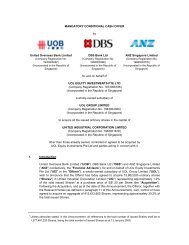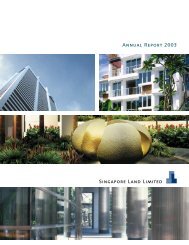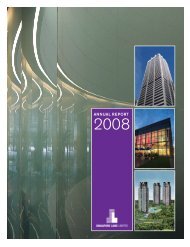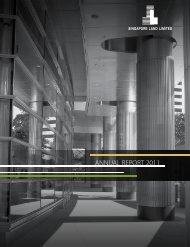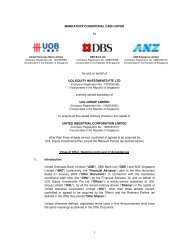Annual Report 2012 - singapore land limited
Annual Report 2012 - singapore land limited
Annual Report 2012 - singapore land limited
You also want an ePaper? Increase the reach of your titles
YUMPU automatically turns print PDFs into web optimized ePapers that Google loves.
Singapore Land Limited - <strong>Annual</strong> <strong>Report</strong> <strong>2012</strong><br />
57<br />
NOTES TO THE FINANCIAL STATEMENTS<br />
For the fi nancial year ended 31 December <strong>2012</strong><br />
2. SIGNIFICANT ACCOUNTING POLICIES (continued)<br />
2.10 Impairment of non-financial assets (continued)<br />
(b)<br />
Intangible assets<br />
Property, plant and equipment<br />
Investments in subsidiary and associated companies, and joint ventures (continued)<br />
An impairment loss for an asset other than goodwill is reversed only if, there has been a change in the<br />
estimates used to determine the asset’s recoverable amount since the last impairment loss was recognised.<br />
The carrying amount of this asset is increased to its revised recoverable amount, provided that this amount<br />
does not exceed the carrying amount that would have been determined (net of any accumulated amortisation<br />
or depreciation) had no impairment loss been recognised for the asset in prior years.<br />
A reversal of impairment loss for an asset other than goodwill is recognised in the income statement, unless<br />
the asset is carried at revalued amount, in which case, such reversal is treated as a revaluation increase.<br />
However, to the extent that an impairment loss on the same revalued asset was previously recognised as an<br />
expense, a reversal of that impairment is also recognised in the income statement.<br />
2.11 Financial assets<br />
(a)<br />
Classification<br />
The Group classifi es its fi nancial assets in the following categories: at fair value through profi t or loss, loans<br />
and receivables, held-to-maturity, and available-for-sale. The classifi cation depends on the nature of the<br />
asset and the purpose for which the assets were acquired. Management determines the classifi cation of its<br />
fi nancial assets at initial recognition and in the case of assets classifi ed as held-to-maturity, re-evaluates this<br />
designation at each statement of fi nancial position date.<br />
(i)<br />
Financial assets at fair value through profi t or loss<br />
This category has two sub-categories: fi nancial assets held for trading, and those designated at fair<br />
value through profi t or loss at inception. A fi nancial asset is classifi ed as held for trading if it is acquired<br />
principally for the purpose of selling in the short term. Financial assets designated as at fair value through<br />
profi t or loss at inception are those that are managed and their performances are evaluated on a fair value<br />
basis, in accordance with a documented Group investment strategy. Derivatives are also categorised<br />
as held for trading unless they are designated as hedges. Assets in this category are presented as<br />
current assets if they are either held for trading or are expected to be realised within 12 months after the<br />
statement of fi nancial position date.






